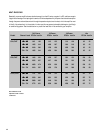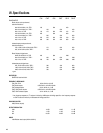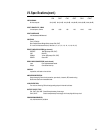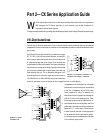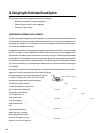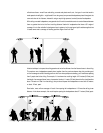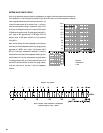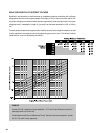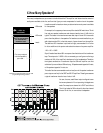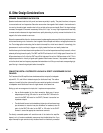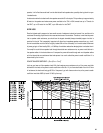
20
1watt in
1 meter
2 meters
3 meters
92 dB SPL
86 dB SPL
82.5 dB SPL
80 dB SPL
4 meters
sensitivity = 92 dB, 1 watt@1m
IX. Designing the Distributed Sound System
There are several main steps in designing a distributed sound system:
• Determining loudspeaker coverage and placement
• Determining power levels for each loudspeaker
• Choosing the right amplifier
LOUDSPEAKER COVERAGE AND PLACEMENT
The goal in placing the loudspeakers in a distributed system is to acoustically cover the required area effectively
but economically. An effective coverage would be one where the sound from the system’s loudspeakers is not
only audible, but intelligible, over all of the area. An economical coverage would be one that achieves the goal
with the fewest loudspeakers necessary.
A loudspeaker in a partially or fully enclosed area produces two sound fields: the direct field, which is sound coming
directly “line-of-sight” from the loudspeaker; and the diffuse field, which is sound from the loudspeaker which
has reflected off of surfaces in the area, such as floors, walls, tables, ceilings, etc. The direct sound field decreases
with distance from the loudspeaker; every time you double the distance, the sound pressure level drops 6 dB.
This is called the Inverse Square Law because the result of a 6 dB sound pressure level decrease is the same
as 1/4 of the sound intensity (i.e., the sound power per square centimeter), which varies inversely with the square
of the distance.
Even though it too is subject to the Inverse Square Law, the intensity of the diffuse field is more difficult to predict,
especially with multiple acoustically reflective surfaces. The problem
is that moving away from one surface may also be moving closer
to another. Controlling the diffuse field often involves
architectural planning as well as acoustical treatment
with absorptive surface materials.
To maintain intelligibility, maximize the
ratio of direct field to diffuse field;
this generally involves placing
the loudspeakers as
close to the listeners
as is both physically
and economically prac-
tical.
Sometimes, a distributed line
system can help a coverage
area with difficult acoustical char-
acteristics. For example, a very re-
verberant room with all large hard,





